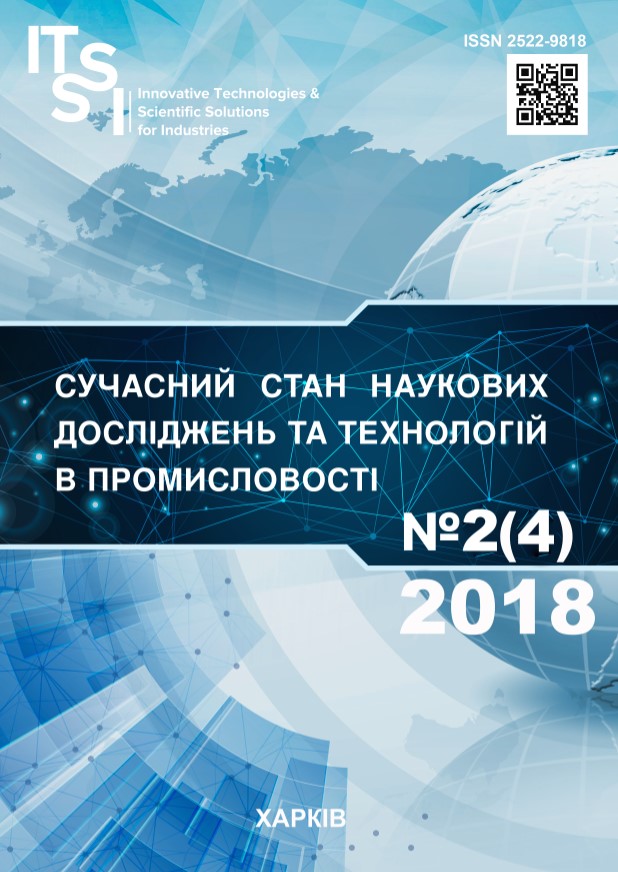ЗМЕНШЕННЯ ЗАТРИМКИ ТРАНЗАКЦІЙ E-LEARNING В КОМП’ЮТЕРНИХ МЕРЕЖАХ ГІПЕРКОНВЕРГЕНТНОЇ АРХІТЕКТУРИ
DOI:
https://doi.org/10.30837/2522-9818.2018.4.019Ключові слова:
e-learning, гіперконвергентна архітектура, транзакція, метод штрафівАнотація
Актуальність дослідження. Інфраструктура, що створена на конвергентній платформі, передбачає об’єднання пам’яті, обчислювальних і мережевих ресурсів в єдиний пул, а при гіперконвергентній архітектурі обчислювальні потужності, сховища, сервери та мережі об’єднуються в одне ціле за допомогою програмних засобів. Це сприяє скороченню експлуатаційних витрат, що особливо істотно для систем підтримки e-learning. Предмет дослідження: процес обробки транзакцій e-learning в комп’ютерних мережах гіперконвергентної архітектури. Метою статті є зменшення затримки транзакцій e-learning в комп’ютерних мережах гіперконвергентної архітектури. Методи, які використовуються при зменшенні затримки транзакцій e-learning: методи теорії множин; оптимізація з використанням штрафних функцій, метод потенціалів. Результати дослідження. Запропоновано метод мінімізації середньої затримки транзакцій в комп’ютерних мережах гіперконвергентної архітектури, що дозволяє побудувати рівномірний розподіл виділених обчислювальних ресурсів для обробки множини транзакцій e-learning по квантах заданого інтервалу часу. У методі будується таке розбиття множини транзакцій на підмножини і їх розподіл по вузлах мережі в процесі розподіленої обробки, при якому середня затримка пакета даних в мережі приймає мінімальне значення і забезпечує рівномірне завантаження мережі для великої кількості абонентів. У запропонованому методі цільова функція завдання пошуку оптимального розбиття множини транзакцій e-learning, оброблюваних в обчислювальної мережі, на підмножини і їх розподілу по вузлах гіперконвергентної мережі, визначається за допомогою введення функції штрафів при виділенні кожній транзакції одиниці обчислювального ресурсу в поточний квант часу. Висновки. Запропоновано підхід до зменшення затримки транзакцій e-learning в комп’ютерних мережах гіперконвергентної архітектури. Підхід ґрунтується на запропонованому методі мінімізації середньої затримки, що враховує особливості гіперконвергентної архітектури. Застосування підходу дозволяє збалансувати мережеве навантаження при великій кількості транзакцій і досягти вимог до оперативності обробки транзакцій e-learning.Посилання
White Paper: Riverbed Hyper-converged Edge, available at : https://www.riverbed.com/document-repository/white-paper--riverbed-hyper-converged-edge.html (accessed 23 April 2017).
Chernyak, L. (2012), "Time of convergent infrastructures" ["Vremya konvergentnykh infrastruktur"], Otkrytyye sistemy. SUBD, No. 4. URL : https://www.osp.ru/os/2012/04/13015754/ (accessed 23 April 2017).
Kuchuk, H. A. (2013), Information Technologies for Integrated Data Flow Control in Information and Telecommunication Networks of Systems of Critical Purpose [Informatsiyni tekhnolohiyi upravlinnya intehralʹnymy potokamy danykh v informatsiyno-telekomunikatsiynykh merezhakh system krytychnoho pryznachennya], Kharkiv : KHUPS, 264 p.
Kuchuk, N., Artiukh, R. and Nechausov, A. (2017), "Method of building the semantic network of distributed search in
e-learning", Innovative Technologies and Scientific Solutions for Industries, No. 2 (2), P. 62–69. Doi: https://doi.org/10.30837/2522-9818.2017.2.062
Kuchuk, H. A., Ruban, I. V., Davikoza, O. P. (2013), "Conceptual approach to structure design of telecommunication network", Information Processing Systems, No. 7 (114), P. 106–112.
Sergiyenko, I. V.(1985), Mathematical models and methods for solving discrete optimization problems [Matematicheskiye modeli i metody resheniya zadach diskretnoy optimizatsii], Kyiv : Nauk. dumka, 520 p.
Gelenbe, E., Pujolle, G. (2010), Analysis and synthesis of computer systems (2nd Edition), Advances in Computer Science and Engineering : Texts, Vol. 4, 309 p.
Whitt, W. (1983), "The Queuing Network Analyzes", Bell System Tech. I, Vol. 62, No. 9, Р. 2779–2815.
Pashnev, A. A., Kuchuk, H. A., Lebedeva, I. A. (2004), "Distribution of computational resource of a homogeneous computer network by quanta of a given time interval" ["Raspredeleniye vychislitel’nogo resursa odnorodnoy vychislitel’noy seti po kvantam zadannogo intervala vremeni"], Information Processing Systems, No. 7 (35), P. 146–153.
Kosenko, V. (2017), "Mathematical model of optimal distribution of applied problems of safety-critical systems over the nodes of the information and telecommunication network", Advanced Information Systems, Vol. 1, No. 2. P. 4–9. Doi: https://doi.org/10. 20998/2522-9052.2017.2.01.
Kuchuk, G., Kharchenko, V., Kovalenko, A., Ruchkov, E. (2016), "Approaches to selection of combinatorial algorithm for optimization in network traffic control of safety-critical systems", East-West Design & Test Symposium (EWDTS), P. 1–6. Doi:https://doi.org/10.1109/EWDTS.2016.7807655.
Kosenko, V. (2017), "Principles and structure of the methodology of risk-adaptive management of parameters of information and telecommunication networks of critical application systems", Innovative Technologies and Scientific Solutions for Industries, No. 1 (1), P. 75–81. Doi:https://doi.org/10.30837/2522-9818.2017.1.046
Kosenko, V. (2017), "Mathematical model of optimal distribution of applied problems of safety-critical systems over the nodes of the information and telecommunication network", Advanced Information Systems, Vol. 1, No. 2, P. 4–9. Doi: https://doi.org/10. 20998/2522-9052.2017.2.01.
Kuchuk, G. A., Kovalenko, A. A., Mozhaev, A. A. (2010), "An Approach To Development Of Complex Metric For Multiservice Network Security Assessment", Statistical Methods Of Signal and Data Processing (SMSDP – 2010): Proc. Int. Conf., October 13-14, 2010, Kiev: NAU, RED, IEEE Ukraine section joint SP, P. 158–160.
##submission.downloads##
Опубліковано
Як цитувати
Номер
Розділ
Ліцензія
Авторське право (c) 2018 Нина Георгиевна Кучук, Александр Александрович Можаев, Сергей Игоревич Шматков, Наталья Викторовна Косенко

Ця робота ліцензується відповідно до Creative Commons Attribution-NonCommercial-ShareAlike 4.0 International License.
Наше видання використовує положення про авторські права Creative Commons для журналів відкритого доступу.
Автори, які публікуються у цьому журналі, погоджуються з наступними умовами:
Автори залишають за собою право на авторство своєї роботи та передають журналу право першої публікації цієї роботи на умовах ліцензії Creative Commons Attribution-NonCommercial-ShareAlike 4.0 International License (CC BY-NC-SA 4.0), котра дозволяє іншим особам вільно розповсюджувати опубліковану роботу з обов'язковим посиланням на авторів оригінальної роботи та першу публікацію роботи у цьому журналі.
Автори мають право укладати самостійні додаткові угоди щодо не комерційного та не ексклюзивного розповсюдження роботи у тому вигляді, в якому вона була опублікована цим журналом (наприклад, розміщувати роботу в електронному сховищі установи або публікувати у складі монографії), за умови збереження посилання на першу публікацію роботи у цьому журналі.
Політика журналу дозволяє і заохочує розміщення авторами в мережі Інтернет (наприклад, у сховищах установ або на особистих веб-сайтах) рукопису опублікованої роботи, оскільки це сприяє виникненню продуктивної наукової дискусії та позитивно позначається на оперативності та динаміці цитування опублікованої роботи.














